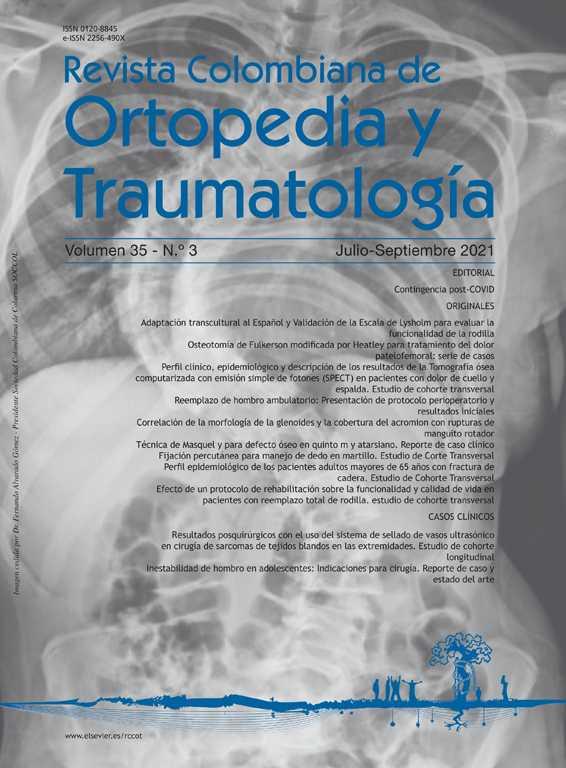Post-surgical results with the use of the ultrasonic vessel sealing system in surgery for soft tissue sarcomas resection in the limbs. A longitudinal cohort study
DOI:
https://doi.org/10.1016/j.rccot.2021.07.002Keywords:
Sarcoma, Soft tissue, Salvage, Sealing, Vessels, Orthopedics, Oncology, Margin resectionAbstract
Background: Limbs soft tissue sarcomas have an incidence of 4.7 cases per 100,000 inhabitants and their surgical management has a high rate of morbidity and mortality due to bleeding. Use of ultrasonic vessel sealing is a novel technique often required. The aim of the study is to determine whether the intraoperative and postoperative results can be improve with the use of ultrasonic vessel sealing systems when surgeons are performing resection surgery of soft tissue
sarcomas.
Methods: A longitudinal cohort was conducted between May 2017 and December 2018, including all patients undergoing resection of soft tissue sarcomas using ultrasonic vessel sealing technology that presented intraoperative and postoperative complications. The variables of age, sex, municipality, neighborhood, occupation, preoperative hemoglobin, intraoperative bleeding, hemovac drainage, postsurgical hemoglobin, seroma, hematoma, need for blood transfusion, and major complications were recorded. Data were analyzed using Shapiro Wilk or Kolmogorov Smirnov for descriptive statistics. Hypothesis tests to compare the occurrence of certain characteristics by stage or severity of the tumor pathology were performed using the Chi2 test or Fisher’s test in qualitative variables, while the quantitative ones with t Student or Mann Whitney, a value of p < 0.05 it was considered statistically significant.
Results: 32 patients were included in the study: 13 women and 19 men; the main types of sarcomas found were spindle cell sarcoma in 11 cases and liposarcoma in 5 cases. A median hemoglobin difference of −1.85 g/dL was found. The use of the ultrasonic bipolar vessel sealing system showed a 71% success rate for surgeries; complications occurred in 12% of patients.
Discussion: Ultrasonic vessel sealing system is a valid alternative that benefits limbs soft tissue sarcomas resection patient surgery by reducing surgery time and improving safer hemostasis. Further randomized controlled studies should be preformed.
Level of evidence: IV
Downloads
References
Wibmer C, Leithner A, Zielonke N, Sperl M. WR. Increasing incidence rates of soft tissue sarcomas? A populationbased epidemiologic study and literature review. Ann Oncol. 2009; 21:1106-11.
Mehren M, Von, Benjamin RS, Bui MM, Casper ES, Iii EUC, Delaney TF, et al. Soft Tissue Sarcoma Version 2. 2012 Featured Updates to the NCCN Guidelines. J Natl Compr Cancer Network. 2012;10:951-60.
Guerrini GP, Bertola G. Soft Tissue Sarcomas Of The Limbs?: Multidisciplinary Treatment. WCRJ. 2017;4:1-7, http://dx.doi.org/10.32113/wcrj20179917.
Rosenberg S, Tepper J, Glatstein E, Costa J, Baker A, Brennan M, et al. The treatment of soft-tissue sarcomas of the extremities: prospective randomized evaluations of limb-sparing surgery plus radiation therapy compared with amputation and the role of adjuvant chemotherapy. Ann surg. 1982;196: 305-15.
Tsukushi S, Nishida Y, Shido Y, Wasa JIN. Clinicopathological prognostic factors of superficial non-small round cell soft tissue sarcomas. J Surg Oncol. 2012;105:668-72.
Potter BK, Adams SC, Qadir R, Pitcher JDTH. Fungating Soft- Tissue Sarcomas. J Bone J Surg (Am). 2009;91:567-74.
Davis LA, Dandachli F, Turcotte R, Steinmetz OK. Limb-sparing surgery with vascular reconstruction for malignant lower extremity soft tissue sarcoma. J Vasc Surg [Internet]. 2017;65:151-6. DOI:https://doi.org/10.1016/j.jvs.2016.05.094.
Chekan EG, Davison MA, Singleton DW, Mennone JZ, Hinoul P. Consistency and sealing of advanced bipolar tissue sealers. Med Devices Evid Res. 2015;8:193-9.
Tseng JF, Ballo MT, Langstein HN, Wayne JD, Cormier JN, Hunt KK, et al. The effect of preoperative radiotherapy and reconstructive surgery on wound complications after resection of extremity soft-tissue sarcomas. Ann Surg Oncol. 2006;13:1209-15.
Marré D, Buendía J, Hontanilla B. Complications following reconstruction of soft-tissue sarcoma: Importance of early participation of the plastic surgeon. Ann Plast Surg. 2012;69: 73-8.
Cortadellas T, Córdoba O, Espinosa-bravo M, Mendoza-santin C, Rodríguez-fernández J, Esgueva A, et al. Electrothermal bipolar vessel sealing system in axillary dissection: A prospective randomized clinical study. Int J Surg [Internet]. 2011;9:636-40. Available from: https://doi.org/10.1016/j.ijsu.2011.08.002.
Yoo YKY, Guner A, Kim H. Comparison of perioperative surgical outcomes between a bipolar device and an ultrasonic device during laparoscopic gastrectomy for gastric cancer. 2015:589-95.





